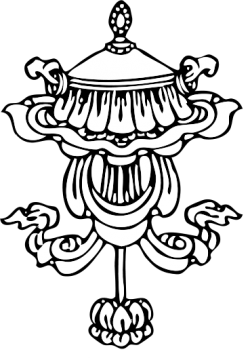The Parasol in Buddhism
The umbrellas symbolizes the dome of the sky, casting its shadow on the earth. This shadow is the shadow of protection. The umbrella is carried above an important person or the image of a deity, to indicate that the person or symbol below the umbrella is the center of the universe. In addition, the umbrella is indicative of the fact that deities are entitled to respect.
The handle of the umbrella is the 'axis mundi,' which is thought to be the central axis sustaining the world. The umbrella is typically depicted to be above the head of an important deity as a way to symbolize that beneath the umbrella is the center of the universe. Some consider the umbrella to be like a mobile temple.
In Tibet some dignitaries are entitled to certain parasols. Religious dignitaries are entitled to silk parasols and secular rulers are entitled to parasols that are embroidered peacock feathers. The Dalai Lama is entitled to both. During processions, a peacock parasol is carried and then a silk one is carried after him. The dome symbolizes wisdom, and compassion is symbolized through the hanging skirt. The parasol itself signifies the union of these two elements. There are also octagonal parasols which symbolize the Noble Eightfold Path and square parasols which represent the four cardinal directions of north, south, east and west.
Above the mountain is the dome of the sky. This is symbolized by the umbrella, whose important function is to cast a shadow, the shadow of protection. The dictionary defines a parasol as an umbrella used for protection from the sun. Thus its function is to protect exclusively from the heat rather than the rain - as the word 'parasol,' meaning 'to hold off the sun,' and 'umbrella,' meaning 'little shade,' similarly imply. The Sanskrit term 'chattra,' also means 'mushroom,' in an obvious reference to its shape.
The parasol or umbrella (Skt. chattra; Tib. gdugs) is a traditional Indian symbol of both protection and royalty. The ability to protect oneself against inclement weather has always, in all cultures, been a status symbol. In Europe, until a few decades ago, a sunshade was a status symbol for society ladies. In Oriental thought, the fact that it protected the bearer from the scorching heat of the sun was transferred into the religious sphere as a "protection against the heat of defilements." Thus the coolness of its shade symbolizes protection from the heat of suffering, desire, and other spiritually harmful forces.
The dome of the umbrella is held aloft by a vertical handle (just like the mountain upholds the sky), which is identified with the 'axis mundi,' or the central axis upholding the world. The umbrella is carried above an important dignitary or the image of a deity, to indicate that the person or symbol below the umbrella is in fact the center of the universe, and also its spiritual support. Umbrellas seem to be especially important in processional rites, being like mobile temples. Thus, depictions of the Buddha often display an elaborate and large umbrella above his head.
As it is held above the head it naturally symbolizes honor and respect. In Vajrayana Buddhism, this large umbrella (atapatra) was even deified into the thousand-armed, -footed goddess Sitapatra, whose name literally means 'the white umbrella.'
In Tibet, depending on their status, various dignitaries were entitled to different parasols, with religious heads being entitled to a silk one and secular rulers to a parasol with embroidered peacock feathers. Exalted personalities such as the Dalai Lama are entitled to both, and in processions, first a peacock parasol and then a silk one is carried after him.
The Tibetan version of the parasol was adopted from its royal Indian and Chinese prototypes, and fashioned from a wooden, spoked frame with a domed silk cover and hanging silk pendants making up an overhanging skirt.
The dome symbolizes wisdom, and the hanging skirt, compassion. Thus the composite form of the parasol signifies the union of these dual elements.
Octagonal and square parasols are also common, representing the Noble Eightfold Path and the four directional quarters respectively.
